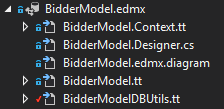TextTemplating files to use with Entity Framework as Code Generation items, avoiding Circular Reference when serialized (json) + DB methods (InsertALotsOfEntity)
The purpose here was to serialise any entity from the framework as json. Two problems were happening:
- Circular Reference Exception (due to navigation properties)
- Proxy class name instead of declared
Also, I took this opportunity to add a DBUtils code generation to add the most basic methods (Get, AddOrUpdate, etc...) but also a InsertALotsOfEntity method to insert more than a thousand entity in a row and very quickly.
-
Software
- Visual Studio 2012 - 2017
- Entity Framework 5
- Compatible with EF6
-
Components
- Applicable under .edmx file
Copy/paste the content of [ModelName].Context.tt and [ModelName].tt, add new Code generation item with the last text templating : [ModelName].tt (with the edmx file open) (I am replacing [ModelName] by the entity model name)
1. Get an entity from DB
Bid proxyBid = null;
using (BidderModelContainer context = new BidderModelContainer())
{
proxyBid = context.Bids.FirstOrDefault(_ => _.Id == bidId);
}
//proxyBid will result as Bid_5BB20962C2C78D24A9CCF63D57FEDDDA5244F675D04549D61FFE37CF20C46439 instance
Bid bidToSerialize = new Bid(proxyBid);
//bidToSerialize will result as Bid instance2. Use DBUtils
- Use same DB context for multiple instructions
IEnumerable<Bid> bids = null;
using (BidderModelContainer context = new BidderModelContainer())
{
bids = BidDBUtils.GetBids(context); //Get all Bid list
Bid bidToUpdate = bids.FirstOrDefault();
bidToUpdate.Name = "New Bid Name";
BidDBUtils.AddOrUpdateEntity(bidToUpdate, context); // updating one Bid instance Name property
List<ValuesHit> values = new List<ValuesHit>();
for (int i = 0; i < 100; i++)
{
values.Add(new ValuesHit() { Value = i.ToString() });
}
ValuesHitDBUtils.AddOrUpdateEntities(values, context); //Adding 100 new ValuesHit instances
context.SaveChanges();
}-
Improve Massive Insert by using InsertALotsOf method Using the following code, I compare two methods to insert massive amount of instance within SQL Server DB.
A ValuesHit object is a quite simple structure with only 2 properties (Id, Value), since the Id property will be defined at the insert time (Primary key), I only populate the Value property.
List<ValuesHit> values = new List<ValuesHit>();
for (int i = 0; i < 2000; i++)
{
values.Add(new ValuesHit() { Value = i.ToString() });
}
ValuesHitDBUtils.AddOrUpdateEntities(values); //here 9496ms to insert 2000 rows
ValuesHitDBUtils.InsertALotsOfValuesHit(values); //here 71ms to insert 2000 rows
Here is a table to compare the execution time of the two methods:
| NB Rows to insert | via AddOrUpdateFromEntity | via InsertALotsOf |
|---|---|---|
| 2000 | 9496ms (~10s) | 71ms |
| 20000 | 79885ms (~1min 20s) | 295ms |
| 100000 | 404116ms (~6min 44s) | 1255ms |
Copyright © 2018 Romain Stiffler https://rstiffler.net.
This is licensed under the terms of the MIT license.
